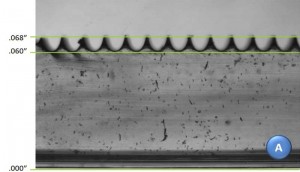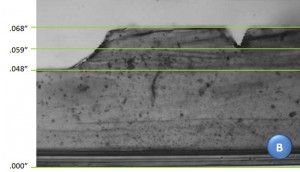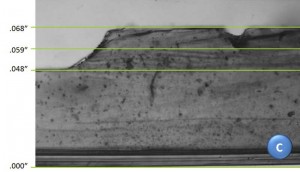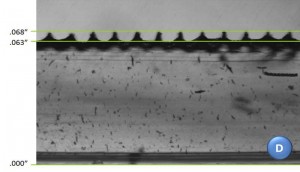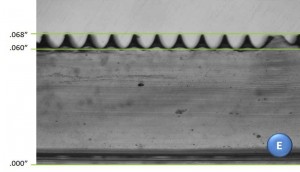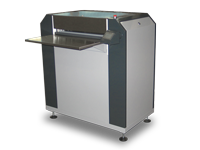Introduction
There is certainly no shortage of articles written on how to store and handle photopolymer printing plates in order to maximize performance and extend life. We know that exposure to ultraviolet light and ozone damages the plate once it reaches production, but when it comes down to reasons for replacing an expensive photopolymer plate the reasons vary greatly. In this multi-part article we will explore some of the more common, but less controlled causes for replacing the plate.
- Part 1 - Plate cleaning
- Part 2 - Plate de-mounting
- Part 3 - Identifying when the plate is worn
First Things First
In this article we will turn our primary focus to plate cleaning. Most of us understand the basics of plate cleaning. We know the importance of selecting a compatible cleaning solution, acceptable methods of wiping the plate to avoid damage to screens, and the importance of cleaning the ink from the plate sooner than later after the production run is complete. There is one aspect of plate cleaning that remains somewhat inconsistent that has a tremendous effect on plate life and performance, and that is a consistent deep cleaning into the screen areas of the plate.
Taking a Closer Look
It is reasonable to assume that a .067" plate that contains screens would have a plate relief (distance from face to floor) of .018" - .025". However if we take a cross cut section through a screen, we can easily see that the relief area between the dots within the screen is actually much less than the surrounding relief. Space between individual dots routinely measure .006" - .010" (see image A). The same holds true for fine reverses within solid print areas (see image B). It is in these areas that ink remains after what can be a good attempt at cleaning the printing plate. The problem isn't just that the effort isn't put forth to clean into these areas, it's the fact that the ink has often thoroughly dried and a saturated lint free cloth or coarse bristled brush just doesn't have the ability to clean deep into these areas.
The Dirty Truth
The result of insufficient cleaning into these problematic areas can drastically diminish plate life and performance. As seen in image C, the relief within a screen can be reduced greatly as ink builds up. This often results in dirty print within the production run. Even after a valid attempt of cleaning, ink often remains in these areas (see image D) and is sent into storage to await the next order. When that plate is pulled from storage and mounted back in the round, that dried ink has one of two directions to go. It either remains locked to the floor within the screen, further reducing the relief and leaving the potential for fill-in; or it begins to flake out in small pieces and is released to the substrate or is re-deposited. Either way, the quality of the print is compromised. When asking a press crew the question, "Do you have a problem with the consistency of plate cleaning?", the answer may often be "no" or "I am not sure." But rarely is the answer "no" when asking press crews if there is ever a problem with dirty print or streaks in the anilox cells from ink particulate lodged between the doctor blade and anilox roll.
Wash Your Hands of the Whole Mess
Automatic plate cleaners were designed not only to effectively clean plates in these problem areas, but they also offer a much more consistent "hands free" result. Not unlike the plate processors that washout out the relief between images and dots during the manufacturing of the plate, soft bristles scrub deep into the relief areas of the plate using solutions that are compatible with solvent, UV, and water-based inks. Some solutions are suitable for all three ink types. The result is a plate that has been returned to its original condition in regards to cleanliness and relief (see image E).
Sooner is Better When it Comes to Cleaning Plates
It is generally understood that after a press run, plates should be cleaned as soon as possible to avoid ink from thoroughly drying on the plate. Ink that has been left to dry for an hour or even more not only requires the individual to work harder to clean the plate, but it also begins to affect the surface energy of the plate which may lead to long term inconsistencies in ink release from plate to substrate. When testing the effects of dried solvent inks on plates, the surface energy had a difference of up to 6 dyne when compared to plates that were cleaned immediately following the production order. This also indicates the importance of consistency when cleaning the plate surface.
Automation Justification
So if it is understood that it is important to clean expensive photopolymer plates immediately, why doesn't it always happen in this fashion? A simple fact is that some people just don't like to do it... me included. Cleaning a plate with large solids is relatively easy, but even given the correct solution, lint free cloths, and soft bristle brushes, it isn't easy to get all the ink out of a screen area. Some individuals claim that the repetitive scrubbing motion gives them pain in their hands and wrist. This repetitive motion can cause muscles and tendons in the hands and wrists to tighten up and lead to carpal tunnel syndrome, and other forms of repetitive stress injury (RSI). But beyond just not wanting to clean plates, the people cleaning plates are often the same people focusing on getting the press set up for the next production order. So even though we say we want the plates cleaned immediately, we may not be willing to enforce this if it has a negative impact on press uptime, so plates often get put by the wayside. Because the operator is not required to babysit the plate washer, it is much easier to get plates cleaner and faster following a press run by allowing pressroom personnel to drop the plates onto a conveyor or multi tray stacking system, letting the machine wash, rinse, and dry the plates.
How an Automatic Plate Washer Works
The dirty photopolymer plate is automatically carried into processor by the transfer rollers. The plate transport speed and temperature are controlled by the computer for consistency; both of which are features that are hard to monitor and maintain when performing this task by hand. Soft bristle brushes with alternating and floating movement offer maximum cleaning capability, while ensuring no damage occurs to the plate. Taking this process out of the hands of various individuals also ensures the correct "safe" cleaning solution is be used, and items like nylons or other abrasives do not come into contact with the plates. Because of the "floating" brush design, any thickness flexo plate will be cleaned quickly and effectively in the automated system. Two types of rinsing systems are available - an open rinse system with fresh water that is led to a drain and a closed loop recirculation system.
More to Come...
In Parts 2 and 3, we will look into minimizing plate damage through automated de-mounting and determine how we can be sure a plate is worn and no longer suitable for use.
APR Technical Solutions Group
We have formed our Technical Solutions Group to encompass our full range of expertise in all critical areas of the flexo process. This team is made up of industry professionals dedicated to being up to date on new technologies, armed with the last in diagnostic tools, and experienced in problem solving that can achieve sustainable results. The TSG have walked in your shoes, and have felt your pain. For any specific questions please feel free to contact me at 847-922-0134 or [email protected].
APR sells our own line of Automatic Plate Cleaners, to learn more, click here.
For more information, call us at 1-800-445-4017, or fill out the Information Request Form.

